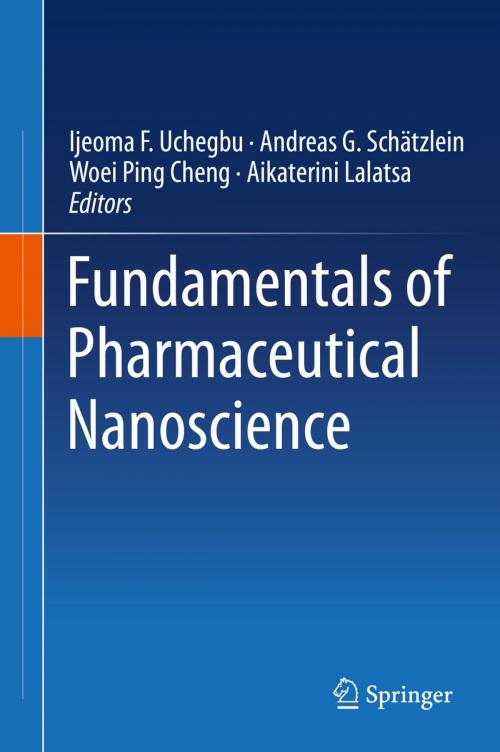Fundamentals of Pharmaceutical Nanoscience
Nonfiction, Health & Well Being, Medical, Specialties, Pharmacy, Medical Science, Pharmacology| Author: | ISBN: | 9781461491644 | |
| Publisher: | Springer New York | Publication: | November 23, 2013 |
| Imprint: | Springer | Language: | English |
| Author: | |
| ISBN: | 9781461491644 |
| Publisher: | Springer New York |
| Publication: | November 23, 2013 |
| Imprint: | Springer |
| Language: | English |
Nanoscience or the science of the very small offers the pharmaceutical scientist a wealth of opportunities. By fabricating at the nanoscale, it is possible to exert unprecedented control on drug activity. This textbook will showcase a variety of nanosystems working from their design and construction to their application in the field of drug delivery. The book is intended for graduate students in drug delivery, physical and polymer chemistry, and applied pharmaceutical sciences courses that involve fundamental nanoscience.
The purpose of the text is to present physicochemical and biomedical properties of synthetic polymers with an emphasis on their application in polymer therapeutics i.e., pharmaceutical nanosystems, drug delivery and biological performance. There are two main objectives of this text. The first is to provide advanced graduate students with knowledge of the principles of nanosystems and polymer science including synthesis, structure, and characterization of solution and solid state properties. The second is to describe the fundamentals of therapeutic applications of polymers in drug delivery, targeting, response modifiers as well as regulatory issues.
The courses, often listed as Advanced Drug Delivery and Applied Pharmaceutics; Polymer Therapeutics; or Nanomedicine, are designed as an overview of the field specifically for graduate students in the Department of Pharmaceutical Sciences Graduate Programs. However, the course content may also be of interest for graduate students in related biomedical research programs.
These courses generally include a discussion of the major principles of polymer science and fundamental concepts of application of polymers as modern therapeutics. All courses are moving away from the above mentioned course names and going by ‘pharmaceutical nanoscience or nanosystems’. This area of research and technology development has attracted tremendous attention during the last two decades and it is expected that it will continue to grow in importance. However, the area is just emerging and courses are limited but they are offered.
Nanoscience or the science of the very small offers the pharmaceutical scientist a wealth of opportunities. By fabricating at the nanoscale, it is possible to exert unprecedented control on drug activity. This textbook will showcase a variety of nanosystems working from their design and construction to their application in the field of drug delivery. The book is intended for graduate students in drug delivery, physical and polymer chemistry, and applied pharmaceutical sciences courses that involve fundamental nanoscience.
The purpose of the text is to present physicochemical and biomedical properties of synthetic polymers with an emphasis on their application in polymer therapeutics i.e., pharmaceutical nanosystems, drug delivery and biological performance. There are two main objectives of this text. The first is to provide advanced graduate students with knowledge of the principles of nanosystems and polymer science including synthesis, structure, and characterization of solution and solid state properties. The second is to describe the fundamentals of therapeutic applications of polymers in drug delivery, targeting, response modifiers as well as regulatory issues.
The courses, often listed as Advanced Drug Delivery and Applied Pharmaceutics; Polymer Therapeutics; or Nanomedicine, are designed as an overview of the field specifically for graduate students in the Department of Pharmaceutical Sciences Graduate Programs. However, the course content may also be of interest for graduate students in related biomedical research programs.
These courses generally include a discussion of the major principles of polymer science and fundamental concepts of application of polymers as modern therapeutics. All courses are moving away from the above mentioned course names and going by ‘pharmaceutical nanoscience or nanosystems’. This area of research and technology development has attracted tremendous attention during the last two decades and it is expected that it will continue to grow in importance. However, the area is just emerging and courses are limited but they are offered.















